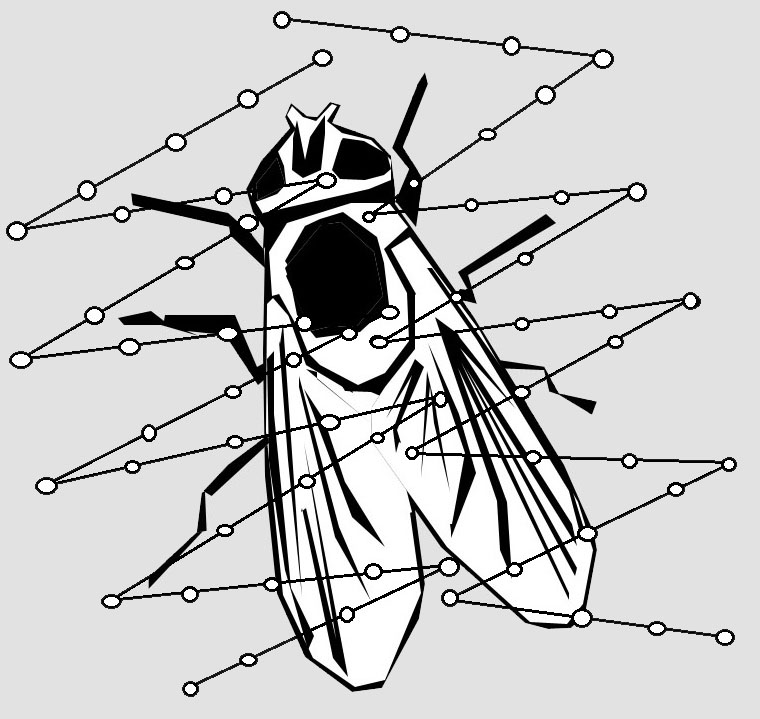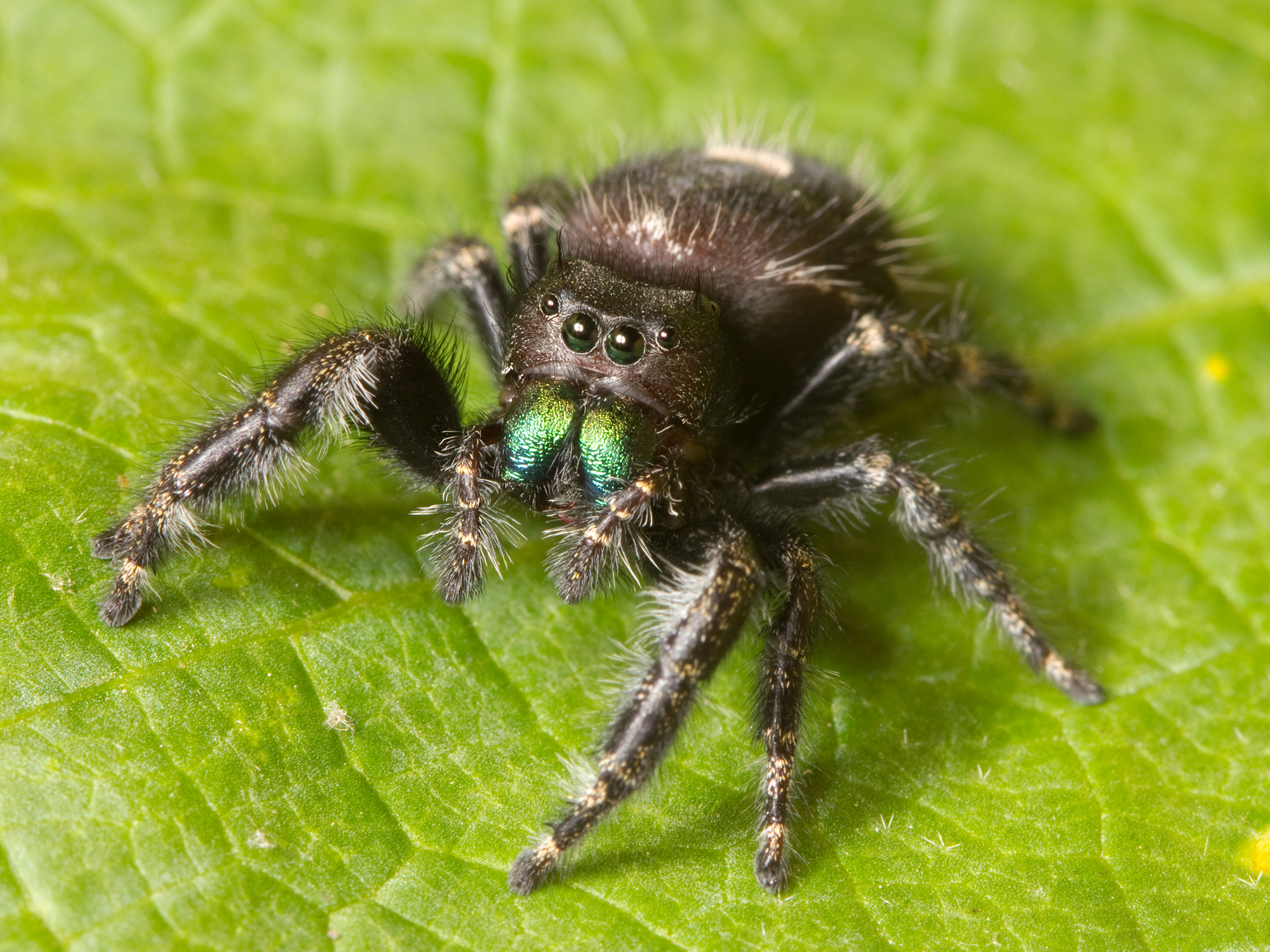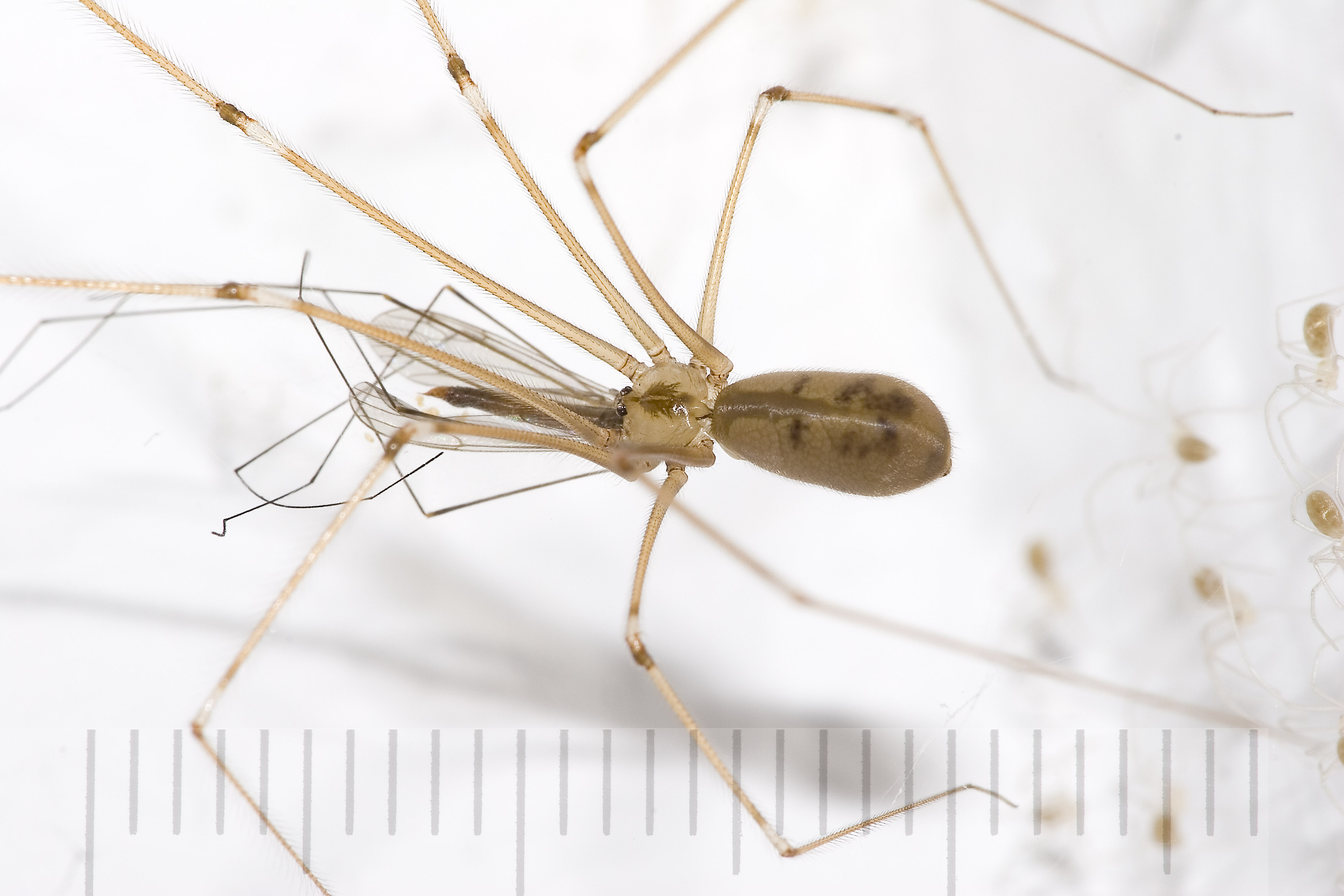|
Scytodidae
Spitting spiders are a family of araneomorph spiders, the family Scytodidae, first described by John Blackwall in 1864. It contains over 250 species in five genera, of which ''Scytodes'' is the best-known. Description Scytodidae spiders are haplogyne, meaning they lack hardened female genitalia. They have six eyes, like most spiders in this group, arranged in three pairs. They possess long legs and a dome-shaped cephalothorax, and are usually yellow or light brown with black spots or marks. Their domed head and three eye groups tend to resemble a human skull, giving them the occasional common name "skull spiders". Hunting technique Scytodidae catch their prey by spitting a fluid that congeals on contact into a venomous and sticky mass. The fluid contains both venom and spider silk in liquid form, though it is produced in venom glands in the chelicerae. The venom-laced silk both immobilizes and envenoms prey such as silverfish. In high-speed footage the spiders can be observed swa ... [...More Info...] [...Related Items...] OR: [Wikipedia] [Google] [Baidu] |
Scytodes
''Scytodes'' is a genus of Scytodidae, spitting spiders that occur all around the world, with the most widely distributed species being ''Scytodes thoracica'', originally having a Palearctic realm, palearctic distribution but has since been introduced to North America, Argentina, India, Australia, Asia and New Zealand. Individuals of the genus are generally characterized by their predominant pale yellow coloration and black markings on their cephalothorax compounded with long, thin hairless legs with black bands. Taxonomy The first species of the genus was first described by Pierre André Latreille as ''Aranea thoraica'' in 1802 through "''Histoire naturelle, générale et particulière des crustacés et des insectes"'' until the genus was later reclassified by Jean Victor Audouin as ''Scytodes'' in 1826. Appearance The genus exhibits sexual dimorphism, males range in size from 3.5 to 4 mm while females are slightly larger ranging from 4 to 4.5 mm. Spitting spiders have pale ... [...More Info...] [...Related Items...] OR: [Wikipedia] [Google] [Baidu] |
Scyloxes
''Scyloxes'' is a genus of Tajikistani spitting spiders containing three species. It was first described by P. M. Dunin in 1992 and remained a monotypic genus until 2022, when Zamani et al. moved two species into the genus, ''S. magna'' and ''S. zhaoi'', from Scytodes and Stedocys, respectively. It is found in Tajikistan, Malaysia and Thailand Thailand, officially the Kingdom of Thailand and historically known as Siam (the official name until 1939), is a country in Southeast Asia on the Mainland Southeast Asia, Indochinese Peninsula. With a population of almost 66 million, it spa .... See also * List of Scytodidae species References Araneomorphae genera Scytodidae Spiders of Asia {{Araneomorphae-stub ... [...More Info...] [...Related Items...] OR: [Wikipedia] [Google] [Baidu] |
List Of Scytodidae Species
This page lists all described species of the spider family Scytodidae accepted by the World Spider Catalog : ''Dictis'' ''Dictis'' L. Koch, 1872 * '' D. edwardsi'' Barrion, Barrion-Dupo & Heong, 2013 — China (Hainan) * '' D. elongata'' Dankittipakul & Singtripop, 2010 — Thailand, Laos * '' D. oranhutan'' Fomichev & Omelko, 2023 — Indonesia (Sumatra) * '' D. soeur'' Saaristo, 1997 — Seychelles * '' D. striatipes'' L. Koch, 1872 (type) — Yemen, United Arab Emirates, Iraq, Iran, tropical Asia, Korea, Japan, China to Australia, Pacific Isles. Introduced to USA, Mexico * '' D. thailandica'' Dankittipakul & Singtripop, 2010 — Thailand * '' D. uncata'' Wu, M. Y. Zhang, M. M. Zhang & Yang, 2023 — China ''Scyloxes'' ''Scyloxes'' Dunin, 1992 * '' S. asiatica'' Dunin, 1992 (type) — Tajikistan * '' S. magna'' Bristowe, 1952 — Malaysia * '' S. zhaoi'' Wu & Li, 2017 — Thailand ''Scytodes'' ''Scytodes'' Latreille, 1804 * '' S. adisi'' Rheims & Brescovit, 2009 — Brazil ... [...More Info...] [...Related Items...] OR: [Wikipedia] [Google] [Baidu] |
Stedocys
''Stedocys'' is a genus of Asian spitting spiders that was first described by H. Ono in 1995. Species it contains thirteen species, found in Asia: * '' S. amamiensis'' Suguro, 2019 — Japan * '' S. gaolingensis'' Wu & Li, 2017 — China * '' S. huangniuensis'' Wu & Li, 2017 — China * '' S. leopoldi'' Giltay, 1935 — Malaysia, Thailand * '' S. ludiyanensis'' Wu & Li, 2017 — China * '' S. matuoensis'' Wu & Li, 2017 — China * '' S. pagodas'' Labarque, Grismado, Ramírez, Yan & Griswold, 2009 — China * '' S. pulianensis'' Wu & Li, 2017 — China * '' S. shilinensis'' Wu & Li, 2017 — China (Hainan) * '' S. uenorum'' Ono, 1995 (type Type may refer to: Science and technology Computing * Typing, producing text via a keyboard, typewriter, etc. * Data type, collection of values used for computations. * File type * TYPE (DOS command), a command to display contents of a file. * ...) — Thailand * '' S. vittiformis'' Chen, Liang, Yin, Xu & Wei, 2021 — China * '' S. xiangz ... [...More Info...] [...Related Items...] OR: [Wikipedia] [Google] [Baidu] |
Dictis
''Dictis'' is a genus of spitting spiders that was first described by Ludwig Carl Christian Koch in 1872. Species it contains seven species, found in Asia, Oceania, North America and Seychelles: *'' Dictis edwardsi'' Barrion, Barrion-Dupo & Heong, 2013 – China *'' Dictis elongata'' Dankittipakul & Singtripop, 2010 – Thailand, Laos *'' Dictis oranhutan'' Fomichev & Omelko, 2023 – Indonesia *'' Dictis soeur'' (Saaristo, 1997) – Seychelles *'' Dictis striatipes'' L. Koch, 1872 (type Type may refer to: Science and technology Computing * Typing, producing text via a keyboard, typewriter, etc. * Data type, collection of values used for computations. * File type * TYPE (DOS command), a command to display contents of a file. * ...) – Yemen, United Arab Emirates, Iran, tropical Asia, Korea, Japan, China to Australia, Pacific Isles. Introduced to USA, Mexico *'' Dictis thailandica'' Dankittipakul & Singtripop, 2010 – Thailand *'' Dictis uncata'' Wu, M. Y. Zhang, M. M. Zha ... [...More Info...] [...Related Items...] OR: [Wikipedia] [Google] [Baidu] |
Scytodes Thoracica
''Scytodes thoracica'' is a spitting spider, so called because it spits a venomous sticky silken substance over its prey. Its size ranges between . The carapace is unusual in sloping upwards towards its rear end, whereas the abdomen slopes downwards. It has six eyes instead of the eight spiders usually have. It has a wide distribution, being found in Europe, North Africa, Turkey, temperate Asia to China, Korea and Japan. It has been introduced to North America, Argentina, India, Australia and New Zealand. This particular spitting spider features the presence of silk glands in its cephalothorax. Besides the silk glands in its abdomen, the spider also has silk glands connected with its venom glands. In this way the spider has the ability to make venomous silk. Other Arachnida, arachnids may also have silk glands in their cephalothorax, such as the pseudoscorpions. Hunting tactics In contrast to the pseudoscorpions that use the silk from the cephalothorax glands to make nests, t ... [...More Info...] [...Related Items...] OR: [Wikipedia] [Google] [Baidu] |
Chelicerae
The chelicerae () are the arthropod mouthparts, mouthparts of the subphylum Chelicerata, an arthropod group that includes arachnids, horseshoe crabs, and sea spiders. Commonly referred to as "jaws", chelicerae may be shaped as either articulated fangs, or as a type of pincer_(biology), pincers. Some chelicerae, such as those found on nearly all spiders, are hollow and contain (or are connected to) venom glands, used to inject venom into prey or a perceived threat. Both pseudoscorpions and Opiliones , harvestmen have additional structures on their chelicerae that are used for grooming (papillae in pseudoscorpions, cheliceral teeth in Opiliones). In ''Paratrechalea'', males and females have shown to have a chelicerae dimorphism, because the chelicerae is used as a mating signal for females. Types Chelicerae can be divided into three kinds: jackknife chelicerae, scissor chelicerae, and three-segmented wikt:chelate, chelate chelicerae. Jackknife chelicerae The jackknife chelicer ... [...More Info...] [...Related Items...] OR: [Wikipedia] [Google] [Baidu] |
Haplogyne
The Haplogynae or haplogynes are one of the two main groups into which araneomorph spiders have traditionally been divided, the other being the Entelegynae. Morphological phylogenetic studies suggested that the Haplogynae formed a clade; more recent molecular phylogenetic studies refute this, although many of the ecribellate haplogynes do appear to form a clade, Synspermiata. Unlike the Entelegynae, haplogynes lack hardened (sclerotized) female genitalia (epigynes). Most of the species within this group have six eyes, as opposed to most other spiders. Spiders in the genus '' Tetrablemma'' ( Tetrablemmidae) have only four eyes, as do some members of the family Caponiidae; caponiids may even have only two eyes. However, spiders in the family Plectreuridae have the normal eight eyes. Phylogeny The Haplogynae are one of the two major groups into which araneomorph spiders were traditionally divided, the other being the Entelegynae. In 2005, Coddington summarized the relationship ... [...More Info...] [...Related Items...] OR: [Wikipedia] [Google] [Baidu] |
Araneomorphae
The Araneomorphae (also called the Labidognatha or "true spiders") are an infraorder of spiders. They are distinguishable by chelicerae (fangs) that point diagonally forward and cross in a pinching action, in contrast to the Mygalomorphae (tarantulas and their close kin), where they point straight down. Araneomorphs comprise the vast majority (about 93%) of living spiders. Distinguishing characteristics Most spider species are Araneomorphae, which have chelicerae, fangs that face towards each other, increasing the orientations that they can employ during prey-capture. They have fewer book lungs (when present) – usually one pair – and the females typically live one year. The Mygalomorphae have chelicerae, fangs that face towards the ground, and which are parallel to the long axis of the spider's body, thus they have only one orientation they can employ during prey capture. They have two pairs of book lungs, and the females often live many years. Image:Cheiracanthium pun ... [...More Info...] [...Related Items...] OR: [Wikipedia] [Google] [Baidu] |
Species
A species () is often defined as the largest group of organisms in which any two individuals of the appropriate sexes or mating types can produce fertile offspring, typically by sexual reproduction. It is the basic unit of Taxonomy (biology), classification and a taxonomic rank of an organism, as well as a unit of biodiversity. Other ways of defining species include their karyotype, DNA sequence, morphology (biology), morphology, behaviour, or ecological niche. In addition, palaeontologists use the concept of the chronospecies since fossil reproduction cannot be examined. The most recent rigorous estimate for the total number of species of eukaryotes is between 8 and 8.7 million. About 14% of these had been described by 2011. All species (except viruses) are given a binomial nomenclature, two-part name, a "binomen". The first part of a binomen is the name of a genus to which the species belongs. The second part is called the specific name (zoology), specific name or the specific ... [...More Info...] [...Related Items...] OR: [Wikipedia] [Google] [Baidu] |
Genus
Genus (; : genera ) is a taxonomic rank above species and below family (taxonomy), family as used in the biological classification of extant taxon, living and fossil organisms as well as Virus classification#ICTV classification, viruses. In binomial nomenclature, the genus name forms the first part of the binomial species name for each species within the genus. :E.g. ''Panthera leo'' (lion) and ''Panthera onca'' (jaguar) are two species within the genus ''Panthera''. ''Panthera'' is a genus within the family Felidae. The composition of a genus is determined by taxonomy (biology), taxonomists. The standards for genus classification are not strictly codified, so different authorities often produce different classifications for genera. There are some general practices used, however, including the idea that a newly defined genus should fulfill these three criteria to be descriptively useful: # monophyly – all descendants of an ancestral taxon are grouped together (i.e. Phylogeneti ... [...More Info...] [...Related Items...] OR: [Wikipedia] [Google] [Baidu] |





